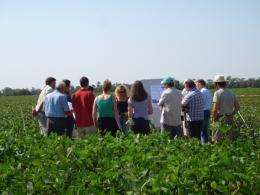Research for Organic Farming - Soya Thrives on Nitrogen From the Air

For the first time, the capacity of soya plants to absorb nitrogen from the air has been precisely determined in dry areas of Eastern Austria. The primary aim of this project, backed by the FWF Austrian Science Fund, is to compare methods for determining nitrogen fixation levels and their application under conditions of drought stress. These methods are of particular interest for organic farming, where soya is playing an increasingly important role. Initial findings were recently presented and discussed at an "open field day".
The soya plant does not depend on artificial fertiliser - quite the opposite in fact. It "fertilises" itself, as it were. By forming a symbiotic relationship with special soil bacteria, soya can use nitrogen from the air, where - unlike in the soil - it is abundant. In actual fact, this ability to absorb nitrogen from the air can also help improve soil quality - even without adding fertiliser. Thus making soya of particular interest to organic farmers. Soya cultivation in Austria would also help cut dependence on protein feed imports. Reason enough, therefore, to investigate the nitrogen fixation of soya further. However, the methods available for measuring this nitrogen fixation are subject to certain limitations.
In dry areas in Eastern Austria, scientists from Bio Forschung Austria are currently testing various methods to measure nitrogen fixation. In particular, investigations are being carried out into the reliability of the various methods with varying availability of water. In the soya-producing areas of Eastern Austria, water is a scarce commodity. This water shortage leads to problems with certain measuring methods. Each measuring method is therefore being tested under two different conditions: with a sufficient water supply and with water shortages. "Until now, there was speculation about whether measurement values are distorted if water is in short supply. Our comparison of the various methods will highlight their strengths and weaknesses. We then hope to have suitable methods to precisely determine nitrogen fixation levels for soya in the Eastern Austrian climate zone," says Dr. Bernhard Kromp, Institute Director at Bio Forschung Austria.
Specifically, the scientists are using two different methods. The first is based on isotope technology. The second method that Dr. Kromp's research team is focusing on measures the concentration of certain substances in the sap - i.e. the particularly nitrogen-rich ureides. These are formed during nitrogen fixation and thus enable a direct conclusion to be drawn on the quantity of fixed nitrogen. "We are now trying to determine whether this method can also be used during water shortages, when the sap is concentrated, so to speak." The findings from comparing the various methods will serve as a basis for explaining further fundamental issues.
An explanation has yet to be found, for example, for how much nitrogen is absorbed by organic soya from the air under the climatic conditions prevailing in Eastern Austria. Dr. Kromp's team is also examining how much nitrogen is actually stored in the roots and therefore how much remains in the soil after the soya is harvested. The effects of drought stress represent a further key area of interest in the research. The results of the work conducted by Dr. Kromp and his team are not just eagerly awaited in scientific circles. They could also produce enormous benefits for organic farming in particular. Farmers, scientists and interested members of the general public were recently given a foretaste during an "open field day", where the background and objectives of the field trials were explained to over 40 participants at first hand.
Initial data from the project indicates that soya cultivation in low-nitrogen soil helps to preserve nitrogen reserves, with the result that more nitrogen is available for plants in the next growing season, even when no fertiliser has been applied on the fields. The project, supported by the FWF, is not only of interest for organic farming. Increased soya cultivation in Austria would also significantly cut the dependence of Austrian livestock farmers on protein feed imports.
Provided by Austrian Science Fund















